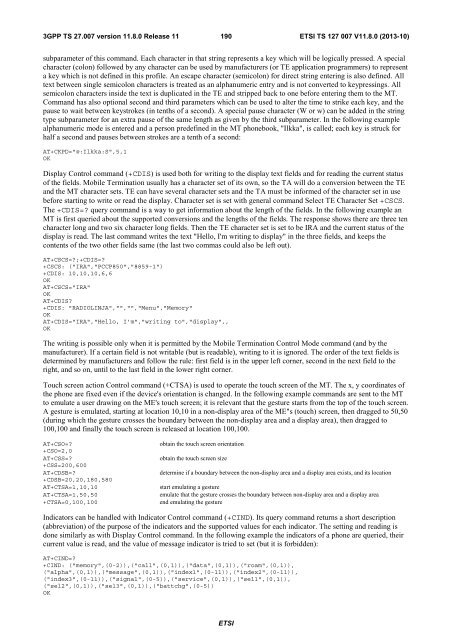ts_127007v110800p
ts_127007v110800p
ts_127007v110800p
You also want an ePaper? Increase the reach of your titles
YUMPU automatically turns print PDFs into web optimized ePapers that Google loves.
3GPP TS 27.007 version 11.8.0 Release 11<br />
190<br />
ETSI TS 127 007 V11.8.0 (2013-10)<br />
subparameter of this command. Each character in that string represen<strong>ts</strong> a key which will be logically pressed. A special<br />
character (colon) followed by any character can be used by manufacturers (or TE application programmers) to represent<br />
a key which is not defined in this profile. An escape character (semicolon) for direct string entering is also defined. All<br />
text between single semicolon characters is treated as an alphanumeric entry and is not converted to keypressings. All<br />
semicolon characters inside the text is duplicated in the TE and stripped back to one before entering them to the MT.<br />
Command has also optional second and third parameters which can be used to alter the time to strike each key, and the<br />
pause to wait between keystrokes (in tenths of a second). A special pause character (W or w) can be added in the string<br />
type subparameter for an extra pause of the same length as given by the third subparameter. In the following example<br />
alphanumeric mode is entered and a person predefined in the MT phonebook, "Ilkka", is called; each key is struck for<br />
half a second and pauses between strokes are a tenth of a second:<br />
AT+CKPD="@:Ilkka:S",5,1<br />
OK<br />
Display Control command (+CDIS) is used both for writing to the display text fields and for reading the current status<br />
of the fields. Mobile Termination usually has a character set of i<strong>ts</strong> own, so the TA will do a conversion between the TE<br />
and the MT character se<strong>ts</strong>. TE can have several character se<strong>ts</strong> and the TA must be informed of the character set in use<br />
before starting to write or read the display. Character set is set with general command Select TE Character Set +CSCS.<br />
The +CDIS= query command is a way to get information about the length of the fields. In the following example an<br />
MT is first queried about the supported conversions and the lengths of the fields. The response shows there are three ten<br />
character long and two six character long fields. Then the TE character set is set to be IRA and the current status of the<br />
display is read. The last command writes the text "Hello, I'm writing to display" in the three fields, and keeps the<br />
conten<strong>ts</strong> of the two other fields same (the last two commas could also be left out).<br />
AT+CSCS=;+CDIS=<br />
+CSCS: ("IRA","PCCP850","8859-1")<br />
+CDIS: 10,10,10,6,6<br />
OK<br />
AT+CSCS="IRA"<br />
OK<br />
AT+CDIS<br />
+CDIS: "RADIOLINJA","","","Menu","Memory"<br />
OK<br />
AT+CDIS="IRA","Hello, I'm","writing to","display",,<br />
OK<br />
The writing is possible only when it is permitted by the Mobile Termination Control Mode command (and by the<br />
manufacturer). If a certain field is not writable (but is readable), writing to it is ignored. The order of the text fields is<br />
determined by manufacturers and follow the rule: first field is in the upper left corner, second in the next field to the<br />
right, and so on, until to the last field in the lower right corner.<br />
Touch screen action Control command (+CTSA) is used to operate the touch screen of the MT. The x, y coordinates of<br />
the phone are fixed even if the device's orientation is changed. In the following example commands are sent to the MT<br />
to emulate a user drawing on the ME's touch screen; it is relevant that the gesture star<strong>ts</strong> from the top of the touch screen.<br />
A gesture is emulated, starting at location 10,10 in a non-display area of the ME"s (touch) screen, then dragged to 50,50<br />
(during which the gesture crosses the boundary between the non-display area and a display area), then dragged to<br />
100,100 and finally the touch screen is released at location 100,100.<br />
AT+CSO=<br />
+CSO=2,0<br />
AT+CSS=<br />
+CSS=200,600<br />
AT+CDSB=<br />
+CDSB=20,20,180,580<br />
AT+CTSA=1,10,10<br />
AT+CTSA=1,50,50<br />
+CTSA=0,100,100<br />
obtain the touch screen orientation<br />
obtain the touch screen size<br />
determine if a boundary between the non-display area and a display area exis<strong>ts</strong>, and i<strong>ts</strong> location<br />
start emulating a gesture<br />
emulate that the gesture crosses the boundary between non-display area and a display area<br />
end emulating the gesture<br />
Indicators can be handled with Indicator Control command (+CIND). I<strong>ts</strong> query command returns a short description<br />
(abbreviation) of the purpose of the indicators and the supported values for each indicator. The setting and reading is<br />
done similarly as with Display Control command. In the following example the indicators of a phone are queried, their<br />
current value is read, and the value of message indicator is tried to set (but it is forbidden):<br />
AT+CIND=<br />
+CIND: ("memory",(0-2)),("call",(0,1)),("data",(0,1)),("roam",(0,1)),<br />
("alpha",(0,1)),("message",(0,1)),("index1",(0-11)),("index2",(0-11)),<br />
("index3",(0-11)),("signal",(0-5)),("service",(0,1)),("sel1",(0,1)),<br />
("sel2",(0,1)),("sel3",(0,1)),("battchg",(0-5))<br />
OK<br />
ETSI


